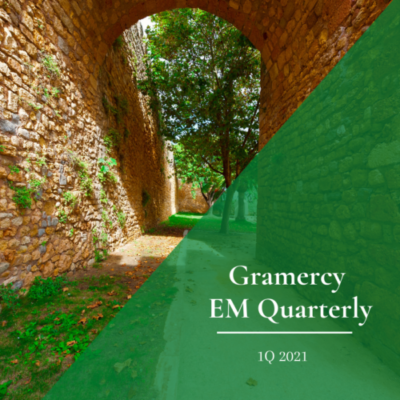Authored by:
- Robert Koenigsberger, Managing Partner & Chief Investment Officer
- Mohamed A. El-Erian, Chair
- Petar Atanasov, Senior Vice President & Co-Head of Sovereign Research
- Kathryn Exum, Senior Vice President & Co-Head of Sovereign Research
January 11, 2021
Decoding the Global Macro Environment: A Top-down Perspective and the Related Implications for Emerging Markets heading into 2021
2020, a year like no other for most of us around the world, is likely to give way to a better, though highly
differentiated, 2021 for the global economy that is still subject to considerable “unusual uncertainty.” We believe that in the first part of the year, most western economies will once again be tested by COVID-19 related disruptions in the context of a shrinking pool of overall resilience. Thereafter, the encouraging prospect of vaccine immunity offers the possibility of a sharp economic rebound, but again quite varied among economies, regions and even sectors and segments of the population within countries.
Operating in such a landscape, most emerging economies cannot, and should not, rely on the global economy to secure growth and financial viability. Domestic policy responses will be even more deterministic in separating the
strong performers from the others, some of which are already starting to run low on financial cushions. Compared to what worked well for emerging markets investors in 2020, the new year is likely to require a much greater degree of portfolio differentiation and more refined risk management that, once again, need to take careful
account of global liquidity conditions (albeit more fluid ones).
When the final numbers come in for 2020, we should expect unprecedentedly large differences in annual growth performance which, in the case of China versus the weakest performing G-7, could amount to as much as 15 to 20
percentage points. The ability of countries to restore healthy economic and social interactions will explain much of these differences; and it is a phenomenon that is likely to prevail also for the first months of 2021.
The gradual deployment of effective vaccines, and the much-hoped for herd immunity that comes with that, offers the scope for more convergence at a higher level of growth. While this process is likely to be frustratingly
gradual and inevitably bumpy, it will end by considerably lifting global growth as a whole. But performance is likely to vary considerably among countries, with public health issues continuing to be of great importance. This will
increasingly matter in a world where debt issuance has been considerable at both the sovereign and corporate level.
Absent greater multilateral coordination and more external funding, some developing countries may well face greater challenges in securing and distributing sufficient vaccines. These are the countries whose initial level of health and financial resilience is most stressed, and where the growth priority is the most urgent.
The willingness of policymakers to maintain their “all in, whatever it takes” approach will increasingly run counter to their ability to do so, as well as from the effectiveness of their intervention. This is least problematic for the systemically important central banks such as the U.S. Federal Reserve and the European Central Bank. Both will
retain their “pedal to the metal” unconventional policy measures until they feel assured of the sustainability of the economic recovery. They will again flood financial markets with liquidity, seeking to shield many investors from a host of risks, but with one important exception: the inability to protect them against the permanent capital impairments that come with bankruptcies and debt defaults.
Other central banks will face greater policymaking complexities, especially in those developing countries with fragilities with respect to the level of international reserves and the risk of disorderly currency movements. Indeed,
as illustrated in 2020 by the dramatic monetary policy U-turn in Turkey, the trade-off between ample monetary support for the economy and maintaining financial stability is likely to become more acute for certain countries.
Fiscal policy responses will also be much more differentiated than in 2020. Despite some encouraging recent developments in several countries, including an incoming Biden Administration both willing and able to increase fiscal support for the U.S. economy, the political will to maintain very high deficits and, in the case of Europe, a certain regionalization of fiscal resources, will come under increased pressure. Rather than stimulate greater structural reforms aimed at countering adverse pressures on productivity, this is likely to delay them further raising questions about longer-term debt and growth dynamics and keeping the risk of trade protectionism high.
When it comes to debt relief for developing countries, most G-20 governments will maintain a highly supportive approach with China increasingly following the lead of the Paris Club. Yet the more they do so, the greater the concerns they are likely to have about “comparability of treatment” and “burden sharing” with private creditors. Continued exploration of a macro approach to ensure better sustainability of private indebtedness – an approach that continues to confront practical obstacles – is likely to be accompanied by much greater insistence for timely private debt restructurings, including of the pre-emptive variety, for countries seeking considerable IMF and World Bank support.
In the transition to a world returning slowly to more normal economic and social interactions, investors in emerging markets will be continuously balancing the caution warranted by challenging economic and debt realities with the upside of seemingly ample and predictable liquidity injections from the west. The inclination “to surf” the massive liquidity wave will remain immense, inevitably leading to pockets of excessive risk taking and mispricings.
The portfolio positioning challenge for investors will likely go beyond what worked extremely well in 2020 – where it was essentially all about liquidity and avoiding extreme “pre-existing conditions” (such as in Argentina and Ecuador). Successful investors will be those using granular analyses to position their portfolios for country, sector and structural themes that play out over time, while also maintaining a dynamic positioning within the asset class underpinned by a high-frequency assessment of global liquidity influences and agile risk hedging programs.
Main Themes Influencing Investment Decisions in 2021
Strong technicals amid expectations for recovery to drive markets in early 2021
2020 was a year most frequently described as “unprecedented”. For the global economy and financial markets, it generated an extraordinary set of challenges and opportunities that investors will continue to grapple with as we
enter the New Year. Markets begin 2021 with an optimistic tone, boosted by the outcome of U.S. elections, positive news around COVID-19 vaccine effectiveness, and the start of vaccination campaigns around the world for the most vulnerable population segments. Naturally, the overarching investment theme across regions, economies, and sectors is “recovery from the pandemic”. However, the journey back to “normality” is likely to be bumpy and uneven, producing winners and losers in global credit markets based on pre-crisis starting conditions and crisis management by governments and corporations alike.
Strong global economic rebound in 2021, but still incomplete recovery…
Assuming that the pandemic is successfully brought under control, 2021 is set for a strong growth rebound in a number of EM and DM economies from the record plunge in 2020 (Exhibit 1). This being said, reaching the pre-crisis level of global economic output will still be a multi-year gradual process (Exhibit 2), with a number of political, social and market implications.
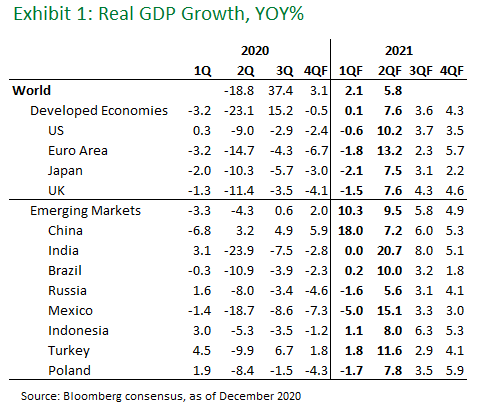
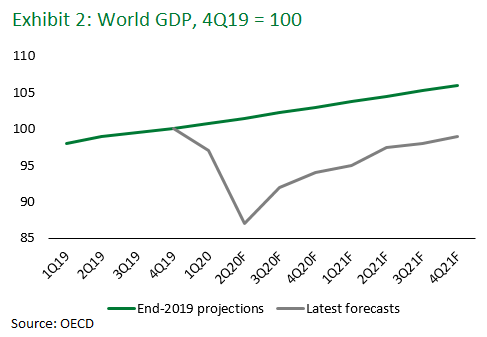 With the ongoing surge in COVID-19 cases across most of the Northern Hemisphere, including in the U.S. and Euro Area, the global economic recovery is poised to lose momentum in 1Q21, with a number of high frequency and mobility indicators pointing in that direction. However, the outlook for the whole of 2021 is supported by the prospect of rapid normalization from 2Q onwards as warmer weather arrives in the large developed economies and multiple, highly effective vaccines are deployed to an increasingly larger segment of the world’s population. In the meantime, global policy support, both monetary and fiscal, remains of paramount importance to bridge economies, companies and consumers to the “light at the end of the tunnel” provided by the expected start of a journey toward global herd immunity through vaccination.
With the ongoing surge in COVID-19 cases across most of the Northern Hemisphere, including in the U.S. and Euro Area, the global economic recovery is poised to lose momentum in 1Q21, with a number of high frequency and mobility indicators pointing in that direction. However, the outlook for the whole of 2021 is supported by the prospect of rapid normalization from 2Q onwards as warmer weather arrives in the large developed economies and multiple, highly effective vaccines are deployed to an increasingly larger segment of the world’s population. In the meantime, global policy support, both monetary and fiscal, remains of paramount importance to bridge economies, companies and consumers to the “light at the end of the tunnel” provided by the expected start of a journey toward global herd immunity through vaccination.
There are numerous risks and uncertainties surrounding the upcoming mass inoculation campaigns: the logistics are daunting and distribution will take time, social acceptance and access will vary, and duration of protection from the virus is still unknown, to name just a few. In that context, the pace of economic recovery will be subject to evidence that the virus is indeed under control and we expect normalization of activity in most sectors to still be gradual as psychological mindsets and consumer behaviors will not change overnight.
For markets, however, the availability of several highly effective COVID-19 vaccines already approved and being deployed as well as a number of other candidates in various stages of development across the world, significantly reduces uncertainty relative to 2020 and provides greater confidence that in 2021 the global economy will begin to transition toward normalization. As such, we believe that markets are likely to look through weakness in 1Q21 and focus on the more optimistic outlook for 2021 as a whole.
….incomplete economic recovery means that policy stimulus and financial repression are here to stay, benefiting emerging markets
A gradual and incomplete global economic recovery is not great news over the medium-term, but for markets in the context of 2021, it comes with a critically important silver lining. We expect the global “liquidity wave” relentlessly provided by the systemically important central banks (Exhibit 3) to remain the most important factor supporting risk markets, including emerging markets (“EM”)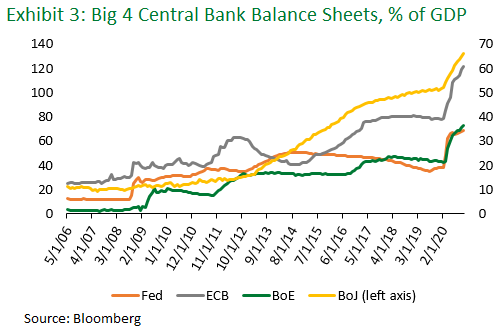 .
.
Another important implication of the gradual and partial economic recovery relative to the pre-crisis trajectory (that was already relatively lackluster) is that inflationary pressure in the global economy in general, and the key
developed markets in particular, should remain muted, despite the likely increase in fiscal stimulus. This gives us comfort that developed market (“DM”) monetary policy is unlikely to change materially in the near-term,
maintaining unprecedented level of accommodation for the foreseeable future.
We believe that the market tailwind of extremely accommodative global monetary policy will not be derailed by the “Blue Wave” scenario that transpired in the US after the recent Senate runoff races in the state of Georgia gave the Democrats full government control over the next two years. In our view, EM will benefit from a shift back to multilateralism and gradual global trade normalization under President Biden in addition to positive spillover effects from likely further sizable fiscal stimulus (to the tune of $750bn-1trn) in the early days of the incoming administration. At the same time, although more fiscal stimulus by a unified Democratic government is likely to prove reflationary this year, we do not expect U.S. interest rates to increase to a level that would challenge our tactically constructive EM outlook.
Until sustained higher inflation materializes, which is unlikely in the near-term, the systemic central banks are set to continue pumping additional liquidity into the global system. To put things in some numerical context, the top eight DM central banks are expected to add liquidity of between 0.5% and 1.0% of their economies’ annual nominal GDP, on average, every month in 2021. In addition to new QE liquidity, we believe that substantial existing liquidity on the sidelines is likely to be increasingly invested and find its way into EM in 2021 as the arrival of effective vaccines helps investors see the light at the end of the COVID-19 tunnel.
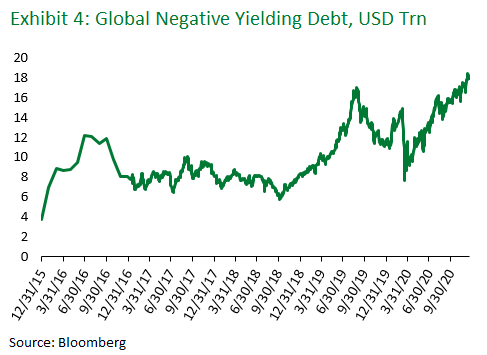 Importantly, new and existing liquidity will continue to be deployed in a context where yield is hard to find. Due to financial repression by the DM central banks, around $18 trillion of bonds trade with negative nominal yields (Exhibit 4) and about 75% of DM sovereign debt trades at negative real yields. This is set to continue to benefit EM assets, in both hard and local currency, amid what we expect to be a “search for yield” environment next year.
Importantly, new and existing liquidity will continue to be deployed in a context where yield is hard to find. Due to financial repression by the DM central banks, around $18 trillion of bonds trade with negative nominal yields (Exhibit 4) and about 75% of DM sovereign debt trades at negative real yields. This is set to continue to benefit EM assets, in both hard and local currency, amid what we expect to be a “search for yield” environment next year.
A continuation of weak USD and oil price recovery will also support EM assets in 2021
Ongoing global economic recovery, especially beyond 1Q21, supported by expectations of a broader vaccine deployment by mid-2021 and the continuation of highly accommodative monetary policies by the U.S. Fed and other systemically important CBs, suggest that two other important tailwinds for EM are likely to persist this year: a generally weak USD environment and further recovery in oil prices.
All else being equal, GDP growth and commodities recovery, accommodative central bank policies, and a weaker dollar create a strong backdrop for EM fixed income assets heading into 2021, providing a counterbalance to a worsening COVID-19 situation that we expect to continue to deteriorate in the first quarter. In addition, the fact that EM bonds are one of the few asset classes that still offer investors the opportunity to earn some yield across global fixed income markets should be supportive of flows in the coming months amid a strong “search for yield” backdrop. In that context, we believe that the right conditions exist in 2021 for outperformance by EM local currency. We favor EM local currency stories that have generally lagged the recovery in late 2020 and are likely to capture a larger share of the total EM inflows amid a supportive top-down environment.
What are some of the main risks that we will be watching for in 1Q21 and beyond, given this overall supportive environment for EM risk? High on our radar will be any indications that larger than expected inflationary pressures are starting to build up in the U.S. economy, especially in terms of core PCE inflation that tends to be the Fed’s favorite gauge, that could derail the “accommodative policy/liquidity wave” narrative. Of course, negative developments on the vaccine front, e.g. evidence that the virus is contained less effectively than currently assumed by experts and markets, will also be critically important.
Mixed medium-term outlook with prospects for upside amid the right policies
The disconnect between the pace of asset price reflation and real economic recovery in the context of unprecedented global liquidity conditions combined with the unequal nature of the COVID-19 shock and recovery leaves downside risks to asset prices and financial stability elevated over the medium-term. We believe that adoption of policies to address the latter should adequately narrow the gap between the former albeit on a differentiated basis.
Renewed multilateralism to benefit EM albeit to varying degrees
The Biden Administration’s aim to restore diplomatic foreign policy with a focus on traditional alliances and multilateral strategies is welcome news for many EM economies and governments. The uncontroversial, centrist, and experienced nature of the Biden cabinet confirms such an approach. The incoming Secretary of State, Anthony Blinken, has been a long-time advisor to Biden and served as Deputy Secretary of State in the Obama Administration. While Biden should have greater room to maneuver on international policy, his initial focus will likely be on domestic issues including COVID-19 management and recovery and growing social and political divides. Such multifaceted foreign policy strategies underpinned by relationships and intelligence take time to establish and evolve and thus, we see most investment implications as medium-term in nature.
U.S. support for multilateral organizations such as the IMF and the World Bank should be stronger under Biden, which means that more funds will likely be available to support highly indebted EMs amid and in the aftermath of the COVID-19 emergency. Africa in particular will likely benefit from increased U.S. attention under a Biden Administration, including further G20 efforts on debt service relief and potential additional SDR allocations at the IMF.
We anticipate a highly nuanced and complex U.S.-China relationship throughout 2021 and beyond, which will involve areas of cooperation and competition as well as confrontation. Defensive measures and tools such as trade, tech, and national security related sanctions utilized by the Trump Administration will likely remain in place initially and only be gradually and partially rolled back following negotiations and exchange for reform progress in these areas. We expect less market disruptive tactics in areas of trade in particular, and a stronger but more diplomatic approach to important areas to the administration such as human rights. Greater research and development in areas of such as technology, climate, cybersecurity and support of regionalization of supply chains is likely on the offensive side. While momentum towards delisting of Chinese ADRs and financial sector related sanctions is probable in the near-term we think negotiations will ultimately fall short of disruptive delistings or substantial financial volatility.
Russia and Turkey are likely to face greater pressure under Biden compared to the prior administration but we expect this to be manageable from an economic and market perspective. On Turkey, the CAATSA sanctions announced in 2020 reduce near-term uncertainty for the credit and give the incoming Biden Administration an opportunity to reset relations with President Erdogan without immediate pressure to impose sanctions. We anticipate a de-escalation of tensions and renewed negotiations with Iran, which results in a new deal to freeze nuclear development and indirectly begins to reduce sanctions in 2021 but falls short of rejoining JCPOA in the backdrop of U.S. domestic constraints. This could result in roughly 500K b/d of additional oil supply by year-end, which should have a moderate downward price impact all-else equal. Improved demand conditions amid recovery along with OPEC management should help to offset the impact.
In Latin America, there is potential for the gradual benefit of regionalization of supply chains over time. While Mexico should be, in theory, well placed to gain, domestic politics will likely prevent it from doing so in a meaningful way. We view risks to Brazil on Amazon deforestation and Mexico on labor related issues as important from an industry and company specific perspective but do not anticipate disruptive tactics or material downside risks to overall relations. Immigration policy should be more supportive for Central American economies than during the Trump term while Argentina and Ecuador should benefit from U.S. backing, primarily through the IMF. The potentially most material, albeit longer-term shift, could come in regard to Venezuela with improved prospects for regime change in 2022-24. We envisage multilateral efforts leveraging the EU and Venezuelan allies (namely Cuba, China and Russia) as well as more effective engagement with the Venezuelan military and domestic players.
Focus on sustainability: ESG to the forefront
The pandemic and associated economic shock combined with political change in the U.S. has accelerated the already existing trends of greater ESG integration and engagement in EM investment analysis and portfolio allocation. We expect more pronounced performance differentiation across countries and corporates with positive ESG trajectories and policies in the post-crisis era. More extensive, explicit, and intentional disclosure of key sustainability issues, projects, and progress will be an important component in generating alpha over time.
Countries and companies that have more constructive E, S, and G profiles and adopt sustainable and resilient economic policies in the aftermath of the current shock should have greater productivity and growth prospects over the medium-term. Public private partnerships will be key in filing the financing gap. We believe this will begin to contribute more materially to FDI and portfolio capital inflows into the most robust ESG markets. This in turn should boost growth potential in select countries, indirectly lower borrowing costs over time and underpin fiscal and balance sheet strength.
The greatest momentum on E in EM has been in Asia with China and South Korea announcing net-zero/carbon neutral targets this year. In order for China to hit its peak CO2 emissions target of 2030, the country will need to transform its energy system and likely launch a nationwide emission trading scheme. The country’s proposed plan is estimated to result in a loss of 1.1mbd of oil demand by 2025 and 2.1mpd by 2030 with solar capacity gains of 20GW in 2021-25 (~65GW total, roughly 1/3 of market demand) and 10GW of wind capacity gains, according to JPM research. Global initiatives on climate will accelerate with the U.S. rejoining the Paris Agreement and potential incorporation of green elements into COVID-19 legislation as well as regulatory efforts. Momentum towards a global carbon price could build ahead of U.S. mid-term elections and would have even more material credit implications for high carbon emitting countries and companies.
At Gramercy, we apply an integrated approach to ESG across the platform, which marries quantitative frameworks with qualitative overlay, due diligence and increasingly robust engagement with sovereigns and corporates over the medium-term. We expect continuation of a still gradual but increasingly firm industry-wide push for more extensive, specific, and proactive issuer disclosure and transparency on UN Sustainability Development Goal progress as well as other key indicators that may prove to be most relevant over time. As this transpires, the delta and trajectory for ESG credit profiles should become increasingly linked to asset price trajectory. We utilize scatterplots which compare Gramercy’s proprietary ESG scores versus traditional credit ratings as well as the JPMorgan EMBIG Diversified spreads coupled with qualitative analysis to assess which sovereigns have potential for spread compression and outperformance on ESG issues as the field moves into the forefront of the investment process (Exhibits 5 and 6 provide a sample of our universe plots).
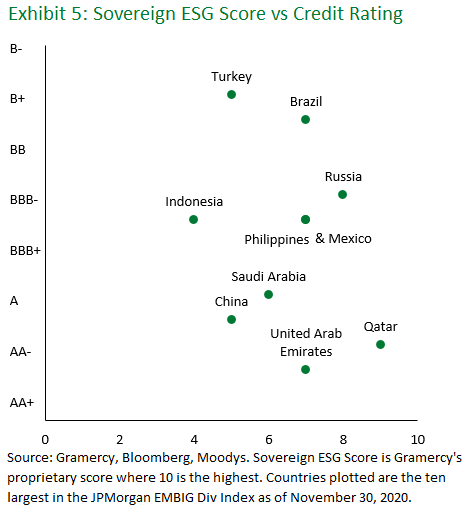
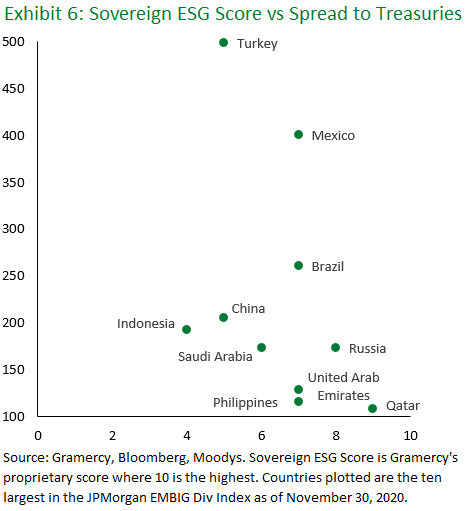
K-shape recovery to drive uncertainty and credit differentiation
The crisis has been the harshest on the most vulnerable countries and segments of society, exacerbating inequality and deepening existing or creating new political divides. The IMF forecasts the post-COVID-19 EM Gini coefficient to exceed 2008 levels, reversing over a decade of progress, as reflected in Exhibits 7 and 8. Real GDP per capita in PPP (purchasing power parity) terms has declined materially across most major EMs with several already experiencing lackluster gains or wealth erosion pre-COVID-19. The necessary immediate support via global central banks and fiscal policy has been sufficient and timely thus far but more comprehensive and sustainable macroeconomic policies will be needed going forward in order to unleash productivity gains and address inequality.
Economic recovery to date has been largely K-shaped in nature with those in the top segments of society experiencing a V-shaped rebound while the others continue to endure sharp losses. Divergence between manufacturing and services sectors persist with outsized job losses in COVID-19 hit industries, such as tourism and hospitality, despite significant and targeted relief. Job markets requiring higher degrees of education have generally held up well in contrast to those that require a high school degree or less. Furthermore, gender inequality is on the rise as women are disproportionately exposed to these sectors and have disproportionately had to step back and out of the workforce amid greater childcare limitations. These dynamics could have long lasting growth and social implications absent resolution.
The unprecedented nature of this crisis as well as the unprecedented state of global monetary and fiscal conditions creates a fair degree of uncertainty regarding the ultimate path forward for social and political systems as well as financial stability. There are several general elections taking place in EM next year amid this challenging social backdrop including Ecuador, Peru, Chile and Zambia as well as important mid-term votes in Argentina and Mexico. Further, South Africa will conduct crucially important wage negotiations. Countries that have comparatively more fiscal space (Exhibit 9) and governments that are willing and able to strike the right balance and coordination of social and economic reform (Exhibit 10) should have better prospects for outperformance over the medium-term.
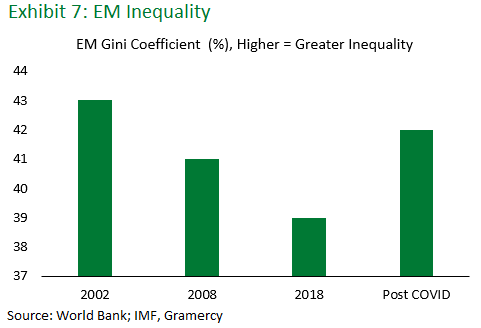
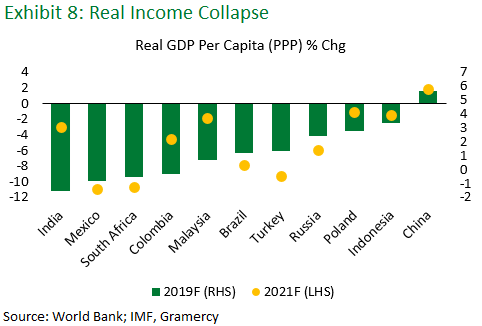
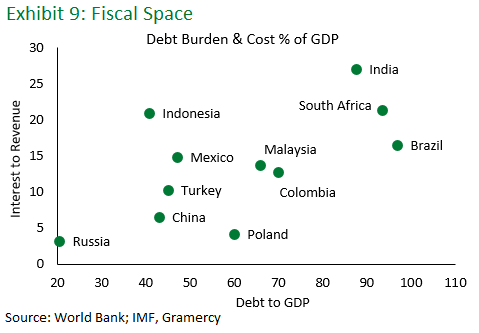
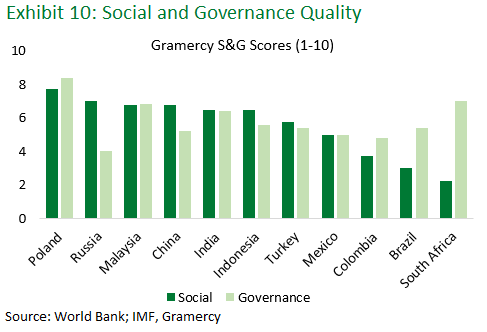
Global Themes and their Implications for Asset Allocation in Emerging Markets
In 2021, we believe that: (1) rates will remain at historically low levels, and (2) central bank balance sheets will keep growing. There is no change in Fed leadership and Yellen (as a known commodity) is unlikely to deviate much on policy. Fiscal stimulus will continue to be made available in the U.S. and EM/DM. The only question is sizing, duration and effectiveness. As a result of the foregoing, public market asset prices should continue to inflate. Subject to a change in current COVID-19 vaccine projections or unforeseen geo-political events, we believe 2021 should be a really good year for risk markets.
We expect that as long as liquidity remains robust, sovereign and corporate issuers will continue to have access to primary markets. If/when we experience bouts of illiquidity or a permanent reversal of liquidity conditions, then primary markets will become tighter and more selective. The resulting impaired market access may force some sovereign issuers to seek multilateral assistance and impose the burden sharing (restructurings) that would accompany such programs. Similarly on the corporate side, lack of liquidity/primary markets could also lead to restructurings and bankruptcies (See Exhibit 11).
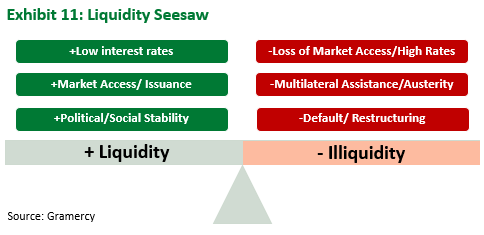 On the COVID-19 front, our view is that the more aggressive “UK strain” is a red herring – any increase in short-term transmission rates will not have long-term consequences beyond further exascerbating what will already be a difficult winter for the UK and any other jurisdiction that potentially experiences this strain. However, now the light at the end of the tunnel is no longer a train but a vaccine(s). All that really matters is their effectiveness and the speed of “roll-out” as we march toward some sort of herd immunity. We will return to the “new, new normal” by the end of this summer as office workers will begin to return in mass to their “hybrid” offices just after Labor Day. In sum, 2021 should be a tale of two halves; the first half hindered by the residual challenges, damages and scarring of the COVID-19 crisis followed by the roaring 2020’s characterized by herd immunity/effective vaccines, the release of pent-up demand and a sharp economic rebound.
On the COVID-19 front, our view is that the more aggressive “UK strain” is a red herring – any increase in short-term transmission rates will not have long-term consequences beyond further exascerbating what will already be a difficult winter for the UK and any other jurisdiction that potentially experiences this strain. However, now the light at the end of the tunnel is no longer a train but a vaccine(s). All that really matters is their effectiveness and the speed of “roll-out” as we march toward some sort of herd immunity. We will return to the “new, new normal” by the end of this summer as office workers will begin to return in mass to their “hybrid” offices just after Labor Day. In sum, 2021 should be a tale of two halves; the first half hindered by the residual challenges, damages and scarring of the COVID-19 crisis followed by the roaring 2020’s characterized by herd immunity/effective vaccines, the release of pent-up demand and a sharp economic rebound.
Geopolitically, we see a high probability that the economic decoupling between China and the U.S. continues. While Biden is surrounded by advisers that are perceived as China friendly (i.e. Blinkin and Sullivan), recent history and Trump policies have successfully changed U.S. public opinion and policy and many global supply chains. This increases the overall business risk of reversing certain supply chains back into China (i.e. if Trump or someone like him can get elected in 2024, why reverse back into China from elsewhere in Southeast Asia even if Biden does lift sanctions just to take risk of re-reversing four years from now). While Biden may be lobbied by U.S. multinationals and Wall Street for a more relaxed China policy, he will not have much domestic political room to reverse many of the Trump era policies (e.g. tariffs) and we believe the U.S. national security apparatus is becoming more China hawkish. The economic concerns informing U.S.-China relations are quickly morphing into more permanent national security issues. The next phase of globalization will likely be driven by establishing a local presence to operate and sell locally rather than merely serving as a supply chain outpost.
So what does all this mean for Emerging Markets? More robust economic activity is good for EM, although growth will be uneven, delineating winners and losers. Stimulus and financial repression are here to stay, combining to be supportive with high demand for yield in both public and private EM credit. That being said, credit differentiation, specialization and the ability to underwrite and structure tailor made credit with adequate credit protections and uncorrelated collateral will prove to be key in navigating the K-shaped recovery.
The digital economy is here to stay as well, but not everything will be digital. We will seek both traditional (airlines, tourism, etc.) and non-traditional (Fintech, online retail, digital infrastructure) opportunities in EM. We expect a weak USD and continued oil price recovery, both of which should be supportive for EM in 2021. However, we wonder if and when we will witness the last hurrah for oil and gas as alternative and renewable energy sources begin to take over. We are on the lookout for when fossil fuels will become the Blackberry of energy. Relatedly, ESG as a material driver for EM investments, is as obvious today as globalization was 30 years ago.
In a world of structurally lower rates for longer, Emerging Markets Debt in hard-currency, especially in U.S. Dollar, is attractive on a relative basis. It remains one of the last scalable sources of yield for institutional investors that require robust investment returns to bridge the gap between their assets and liabilities without significant incremental risk. Indeed, Emerging Markets Debt’s consistently-better Sharpe Ratio compared to developed markets fixed income asset classes (namely, U.S. Investment Grade and High Yield), has, in Gramercy’s opinion, earned it a place as a core strategic allocation for institutional investors. Yet, this is not an asset class that is suitable for index funds. The need for active management is even more important in the difficult macroeconomic backdrop in which we find ourselves today, with a global pandemic going into second and third waves across the world that may have long-lasting consequences on global GDP, globalization and debt repayment behavior.
Despite the Emerging Markets Debt universe in hard-currency being a primarily an investment grade asset class, there will be significant headwinds to navigate. From a top-down perspective, next to the increasing importance of central bank policies and government stimulus, geopolitical risks as well as commodity markets, it is even more crucial to develop a deep understanding of valuations and technical drivers. A strong top-down framework will prove to be a key success factor in a world of detached valuations that are driven by technical factors more than macroeconomic and corporate fundamentals. However, while necessary, it will not be sufficient. Bottom-up factors will be as important, if not more, in certain circumstances. This is particularly true for granular analyses of creditworthiness, liquidity and other micro valuation metrics. Credit selection will be more critical than ever to avoiding unrecoverable mistakes and better managing downgrade risks. A deep pool of emerging markets investment professionals with experience through the credit cycle will be critical to successfully managing the increasingly difficult environment into 2021.
Investors seem to agree with our conclusions. As of December 2020, according to EFPR, inflows into Emerging Markets Debt in hard currency total $4.7bn and a stunning $24.4bn since April of 2020. In light of new lockdowns announced on a weekly basis, even a potential double-dip recession in much of the advanced world might not derail the investment case of Emerging Markets Debt in hard-currency so long as central banks response is timely. In fact, with highly effective vaccines being the light at the end of the tunnel, it might be a buying opportunity but one needs to know what to buy and manage it actively.
Within Private Credit, we see continued investment opportunities focused on trade finance, infrastructure and energy projects. From a geography perspective, we see a robust pipeline in Brazil, Mexico, Peru, Colombia, Turkey and Africa, especially for those companies that cannot access the capital markets but still want to take advantage of growth opportunities in their underlying businesses. We will continue to leverage our dedicated, local lending platforms to source, onboard, manage and monetize these credits.
In our Opportunistic Credit Strategies, we will continue to dynamically shift between high yield, dislocated and distressed opportunities. Ex-ante, we will use our distressed DNA to properly shield portfolios from defaults and bankruptcies and then ex-post to underwrite those situations whereby prices are materially below recovery values due to illiquidity/lack of index sponsorship (See Exhibit 12).
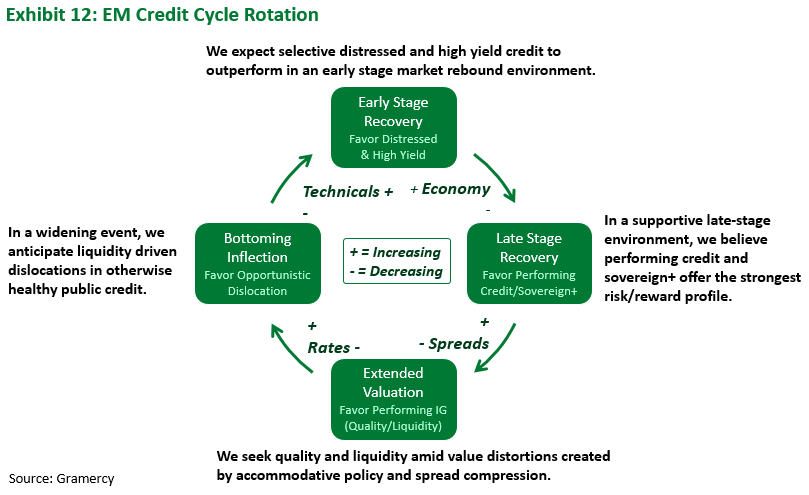
On a few specific names, in Venezuela, we believe that Biden will have more domestic political room to reverse tough Trump policies. The supporters of these policies primarily reside in South Florida, voted overwhelmingly Trump and are unlikely to swing Democrat anytime soon anyway. We believe that Biden will initially leave the sanctions in place as negotiating leverage and thereafter tone down the aggressive rhetoric with a softer approach. Current sanctions combined with the Biden approach/international diplomacy could be a very powerful combination for a political resolution in Venezuela that is planted in 2021 and harvested via internationally observed elections in 2022.
In Argentina, despite the political noise and volatility, pragmatism on all sides should deliver an Extended Fund Facility with the IMF by March or April. With Argentina yields 500-1000 basis points cheap to single-B rated comps, we believe the IMF agreement should catalyze materially lower yields/higher prices.
In Special Situations, we see continued investment opportunities in litigation finance, particularly in international arbitration related to EM countries. We also believe that we can continue to capitalize on insurance claims as its own asset class, both as a basis for litigation finance opportunities but also as a borrowing base for bespoke credit opportunities.
 In conclusion, despite certain risks and uneven initial conditions, we believe 2021 will prove to be a strong year for both economic and financial market performance in certain EM markets and assets. We intend to lean-in and participate in both public and private EM credit markets as well as in special situations. However, we will do so in a disciplined, “happy trade” fashion whereby we scale-in over-time and will be happy to see markets rally and/or dip for further buying opportunities. We will also be keen to differentiate between winners and losers. This will entail constant triage of both top-down and bottom-up factors that will inform dynamic asset position/allocation, planning the trade/trading the plan and agile hedging.
In conclusion, despite certain risks and uneven initial conditions, we believe 2021 will prove to be a strong year for both economic and financial market performance in certain EM markets and assets. We intend to lean-in and participate in both public and private EM credit markets as well as in special situations. However, we will do so in a disciplined, “happy trade” fashion whereby we scale-in over-time and will be happy to see markets rally and/or dip for further buying opportunities. We will also be keen to differentiate between winners and losers. This will entail constant triage of both top-down and bottom-up factors that will inform dynamic asset position/allocation, planning the trade/trading the plan and agile hedging.
We thank everyone for their partnership and support in 2020. We wish you, your teams and your families a Happy and Healthy 2021.
About Gramercy
Gramercy is a dedicated emerging markets investment manager based in Greenwich, CT with offices in London, Buenos Aires and Mexico City with dedicated lending platforms in Mexico City and Istanbul. The firm, founded in 1998, seeks to provide investors with superior risk-adjusted returns through a comprehensive approach to emerging markets supported by a transparent and robust institutional platform. Gramercy offers alternative and long-only strategies across emerging markets asset classes including multi-asset, capital solutions, private credit, distressed debt, USD and local currency, sovereign, high yield/corporate debt, and special situations. Gramercy is a Registered Investment Adviser with the SEC and a Signatory of the Principles for Responsible Investment (UNPRI). Gramercy Ltd, an affiliate, is registered with the FCA.
Contact Information:
Gramercy Funds Management LLC
20 Dayton Ave
Greenwich, CT 06830
Phone: +1 203 552 1900
www.gramercy.com
Joe Griffin
Managing Director, Business Development
+1 203 552 1928
[email protected]
Investor Relations
[email protected]
This document is for informational purposes only, is not intended for public use or distribution and is for the sole use of the recipient. It is not intended as an offer or solicitation for the purchase or sale of any financial instruments or any investment interest in any fund or as an official confirmation of any transaction. The information contained herein, including all market prices, data and other information, are not warranted as to completeness or accuracy and are subject to change without notice at the sole and absolute discretion of Gramercy. This material is not intended to provide and should not be relied upon for accounting, tax, legal advice or investment recommendations. Certain statements made in this presentation are forward-looking and are subject to risks and uncertainties. The forward-looking statements made are based on our beliefs, assumptions and expectations of future performance, taking into account information currently available to us. Actual results could differ materially from the forward-looking statements made in this presentation. When we use the words “believe,” “expect,” “anticipate,” “plan,” “will,” “intend” or other similar expressions, we are identifying forward-looking statements. These statements are based on information available to Gramercy as of the date hereof; and Gramercy’s actual results or actions could differ materially from those stated or implied, due to risks and uncertainties associated with its business. Past performance is not necessarily indicative of future results. This presentation is strictly confidential and may not be reproduced or redistributed, in whole or in part, in any form or by any means. © 2020 Gramercy Funds Management LLC. All rights reserved.
